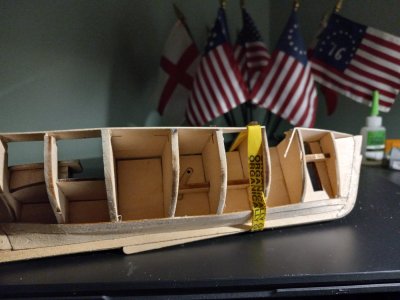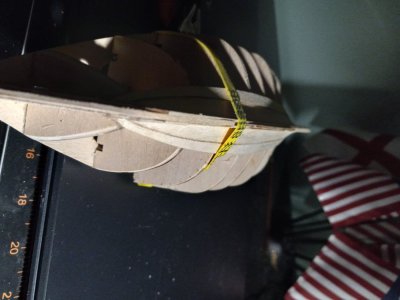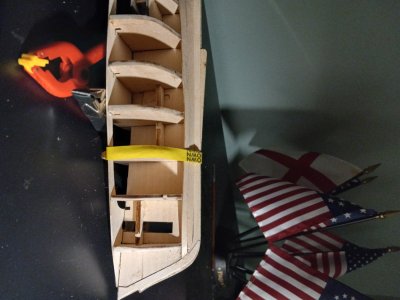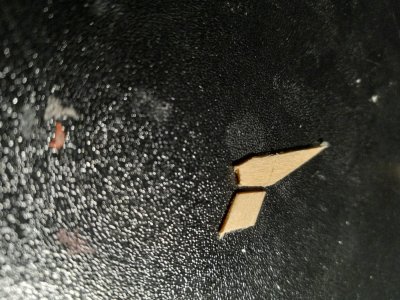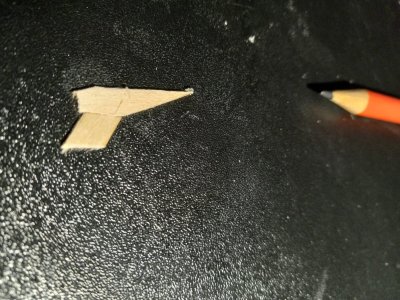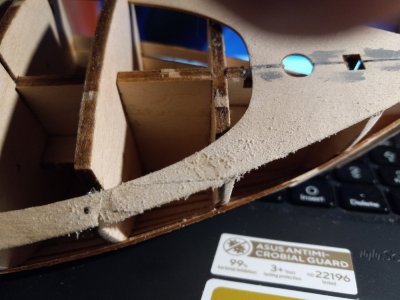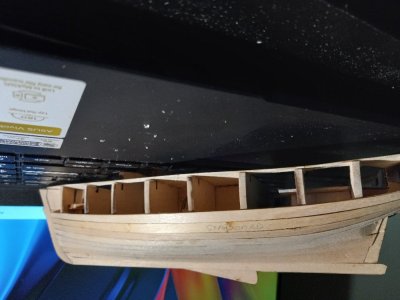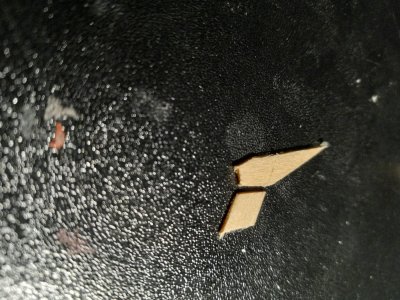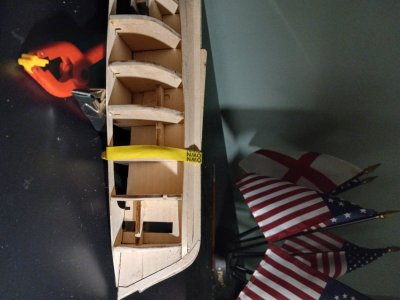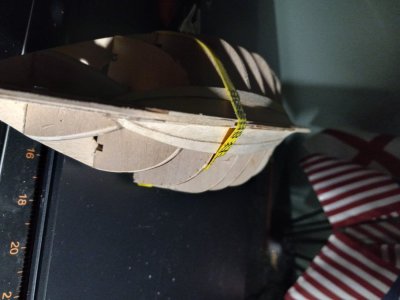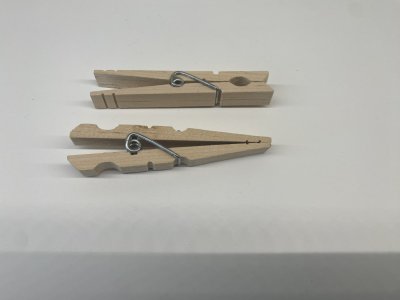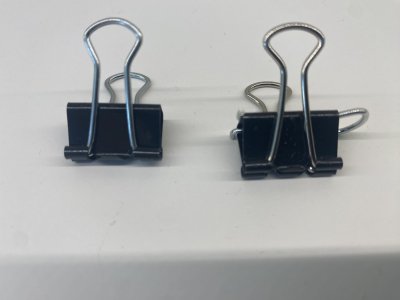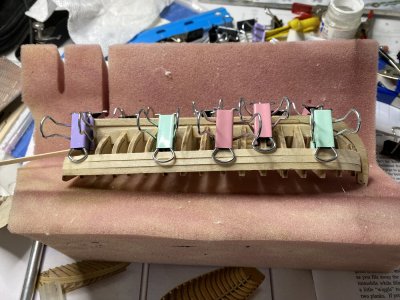Got the Garboard planks in, soaking the planks in a glass of boiling water for a couple of minutes,
-

Win a Free Custom Engraved Brass Coin!!!
As a way to introduce our brass coins to the community, we will raffle off a free coin during the month of August. Follow link ABOVE for instructions for entering.
You are using an out of date browser. It may not display this or other websites correctly.
You should upgrade or use an alternative browser.
You should upgrade or use an alternative browser.
Bah! Humbug!Waiting for repaired deck to dry.
I found that with my first dory I spent nearly as much time repairing my mistakes as I did building my model. I'm not a patient man except when I sit down to my work bench. Who knew that this hobby would teach me patience, my wife might disagree.
These are the clamps I have been using. The metal ones have more holding power but will leave marks on soft balsa and indentations. I broke several planks at the bow using them so care is needed. The plastic ones do not damage the wood but are more difficult to position and I use rubber bands too.
Any suggestions for better clamps?
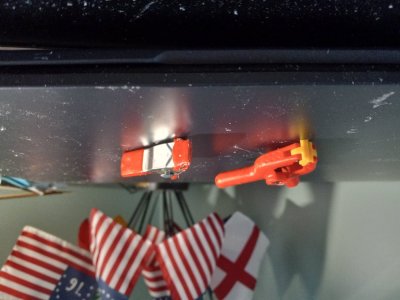
Any suggestions for better clamps?

Thanks, using the clothespinsYou can pad the wood you are clamping with small pieces of scrap wood. You can also repurpose clothes pins to grip better and modify binder clips to act as clamps use the "handles" of one clip and place them in the base of two others. Both work well. You never have enough clamps!
View attachment 549774
View attachment 549775
View attachment 549776
Rob
Going to take some sanding and putty. Sheer plank is next. First ever planking a wooden hull. Not as well done as I would like, but passable, I broke the decking three times, crimped the planking at the bow 2 times with my metal clamps, soaked the planking in boiling water for four minutes, think 5 or 6 minutes might have been better. I didn't glue the plank logitudinal ends together, that may have resulted in a better job. If this were a real ship, the crew would have gone crazy bailing out the sea!
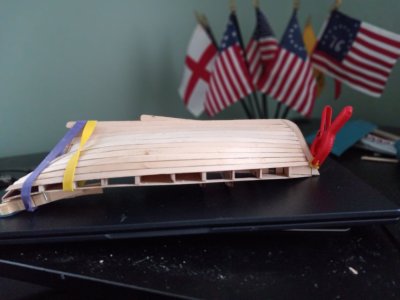
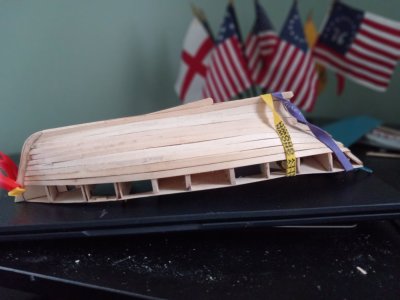


Last edited:
- Joined
- Oct 1, 2023
- Messages
- 1,945
- Points
- 488

I'll be following your build.A few years into my retirement I have decided to attempt wooden ship model building. My first foray is the Model Expo Lowell Grand Banks Dory.
I know my skill set would make the three-piece bottom fairly simple. However, as it is my first build I took the easy way out and chose the one-piece bottom.
View attachment 530240
I measured and marked out the cleats, and chamfered the edges before cutting them, requiring only chamfering the ends when placing them.
View attachment 530241
Following the guide I prepared and installed the stem and transom. Then set the bottom curve.
View attachment 530242
View attachment 530243
I encountered an issue (my own) with the frames. They assembled all right. Getting them into the jig, and having them set at 90 degrees was the first issue. After sanding the inside of the slots, where needed, I placed each from and support. I found I needed to file opposite top and bottom long edges to get the frames to align at 90 degrees.
View attachment 530244
Now, my next issue with the frames. In a number of builds there were comments about the fragility of some wood pieces due to the angle of the grain to the piece. I found that out the hard way. Attempting to be as careful and gentle as possible I had two frames break from the rubber band pressure. For one frame the broken piece landed in the middle of the workspace. The second broken piece disappeared into the ether. [Update: When cleaning up after this build, before starting the Norwegian Pram, I found the errant piece on a window sill. Oof.] Using the template I was able to manufacture the missing piece. Unfortunately, I miscalculated and the piece was a tad short. When the bottom was laid out over the frames there was a gap of a few millimeters. I filled the gap with a piece of scrap from a piece sheet that was the right thickness. Glued that in place, and sanded to shape. What I learned from this particular occurrence is in the future, put the template on a piece of carboard or dense foam and use pins to wedge the pieces in place while mapping out the 'missing' section.
View attachment 530247
Forming and attaching the garboard planks presented a minor problem. While soaking the port plank I used a metal weight to hold under the water. Oops. The metal left a stain, Hoping paint will correct that error. While working the starboard plank, sanding down to the laser printed sanding mark, the edge split and separated along much of the the mark. Apparently I put too much lateral pressure on the edge while cleaning them up. using diluted PVA glue I filled the gap and clamped the piece in place.
View attachment 530248View attachment 530249
So, to this point I have the port garboard plank glued in place, and the starboard garboard plank bent. While bending the starboard plank the plank split at the guide line, again. Re-glued and clamped. Will attempt to glue into place later today.
View attachment 530250
Has been quite enjoyable, a real test of patience (waiting for the next step).
Cheers
Welcome to SOS.
This was also my first kit.
Now I'm building a four foot San Felipe
Happy modeling
- Joined
- Oct 1, 2023
- Messages
- 1,945
- Points
- 488

Not familiar with this kit, but if like most kits today, planking and frames are basswood. While basswood works fine for planking, it might be too weak for the frames, especially since scantlings (framing) are small in these open boats.
It looks like the drawings are like those for the old balsa, tissue model airplanes; you can build the frames by pinning them to the drawing. Therefore, why not use a stronger wood for the frames on your next dory model. Wooden Popsicle sticks would be a good choice, provided you have a way to saw them to the required profile. You have the kit supplied basswood frame parts to use as patterns.
If you don’t have the necessary tools to do this, it might be a good time to invest in some. The very simple hand tools required need not be expensive and will be used over and over again on future models.
it seems the tools and reusable supplies add up to as much as the model
I was disappointed with the quality of the balsa wood. One thing I noticed is the thickness of the balsa was almost identical, but off enough to cause planking problems. Next model, I will check and sand if needed, would pearwood be better for framing? The next time I'll try walnut for planking.
I have to pay my wife a dollar for every cuss word, so in addition to learning patience I find myself financing her forays to her favorite store.

I have to pay my wife a dollar for every cuss word, so in addition to learning patience I find myself financing her forays to her favorite store.
I found that with my first dory I spent nearly as much time repairing my mistakes as I did building my model. I'm not a patient man except when I sit down to my work bench. Who knew that this hobby would teach me patience, my wife might disagree.
I'm prepping the sheer plank. There are some areas of the decking that rise above the sheer plank, due to repairs where I broke the decking. I will glue an extra piece to the sheer and sand it down to the deck...two more dollars to the boss!
Think I'll get some PVA at Home Depot. I've been using old glue I had on hand and it's "ok", but fresh will be better. The sheer planks have been soaked in boiled water for 6 minutes, test fitting, not glued yet .Off slightly at the stern where the deck meets the sheer, one of the repair spots where the framework had been broken. I'll slice a piece of similar size, glue it atop the sheer, then sand it down.I'm prepping the sheer plank. There are some areas of the decking that rise above the sheer plank, due to repairs where I broke the decking. I will glue an extra piece to the sheer and sand it down to the deck...two more dollars to the boss!
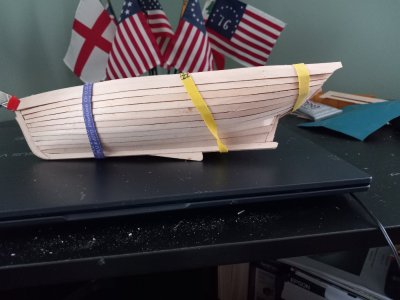
Last edited:
There is a problem with the plank to deck fitting at the stern and I will have to figure out a fix. This is at the point where I broke some of the framing. It looks like the wifey gets a few more dollars. I have no access to the framing, so will do the best I can then engage in some camouflage, filling in damaged areas with putty.
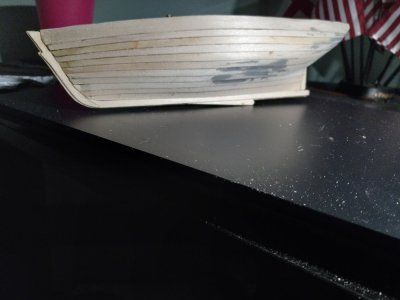
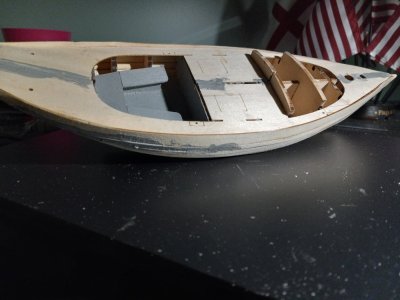
Last edited:
My wife collects a dollar for each cuss word.I found that with my first dory I spent nearly as much time repairing my mistakes as I did building my model. I'm not a patient man except when I sit down to my work bench. Who knew that this hobby would teach me patience, my wife might disagree.
If my Admiral did that she would be a millionaire.My wife collects a dollar for each cuss word.
The planking is looking Good! Not sure what kind of filler you are using there but you may want to try Elmers wood filler. It matches the wood better, is inexpensive and sands like wood when dry.
Rob
Been using putty. Elmer's makes good glues, going to get that at Home Dept, will try the filler too. I used Squadron grey putty. Cross sanding planking to get a smoother finish. I am sorry I used Squadron's putty as now I have to paint the hull, and I like the finished wood look better, never liked the fiber glass look.The planking is looking Good! Not sure what kind of filler you are using there but you may want to try Elmers wood filler. It matches the wood better, is inexpensive and sands like wood when dry.
Rob
Last edited:


